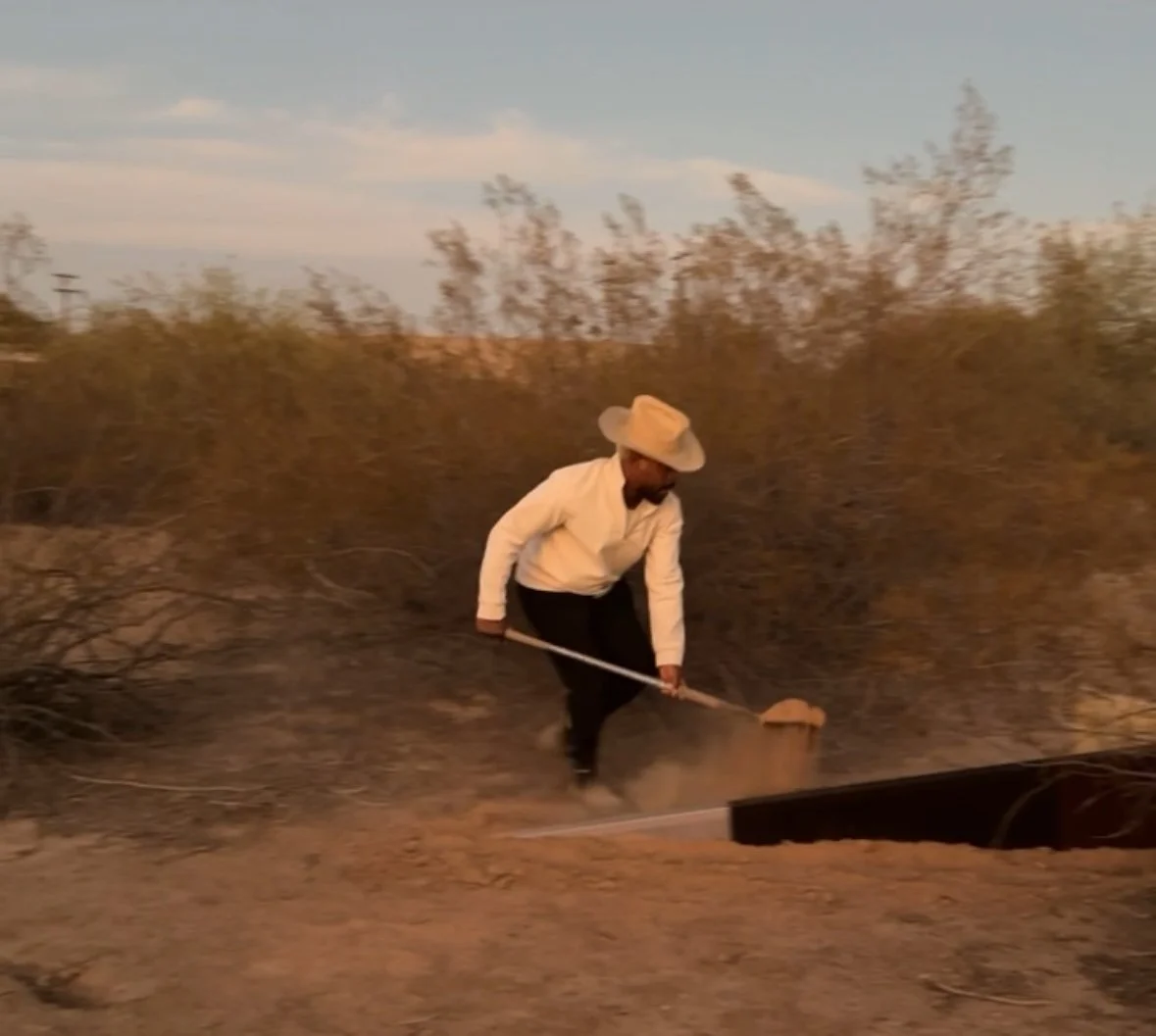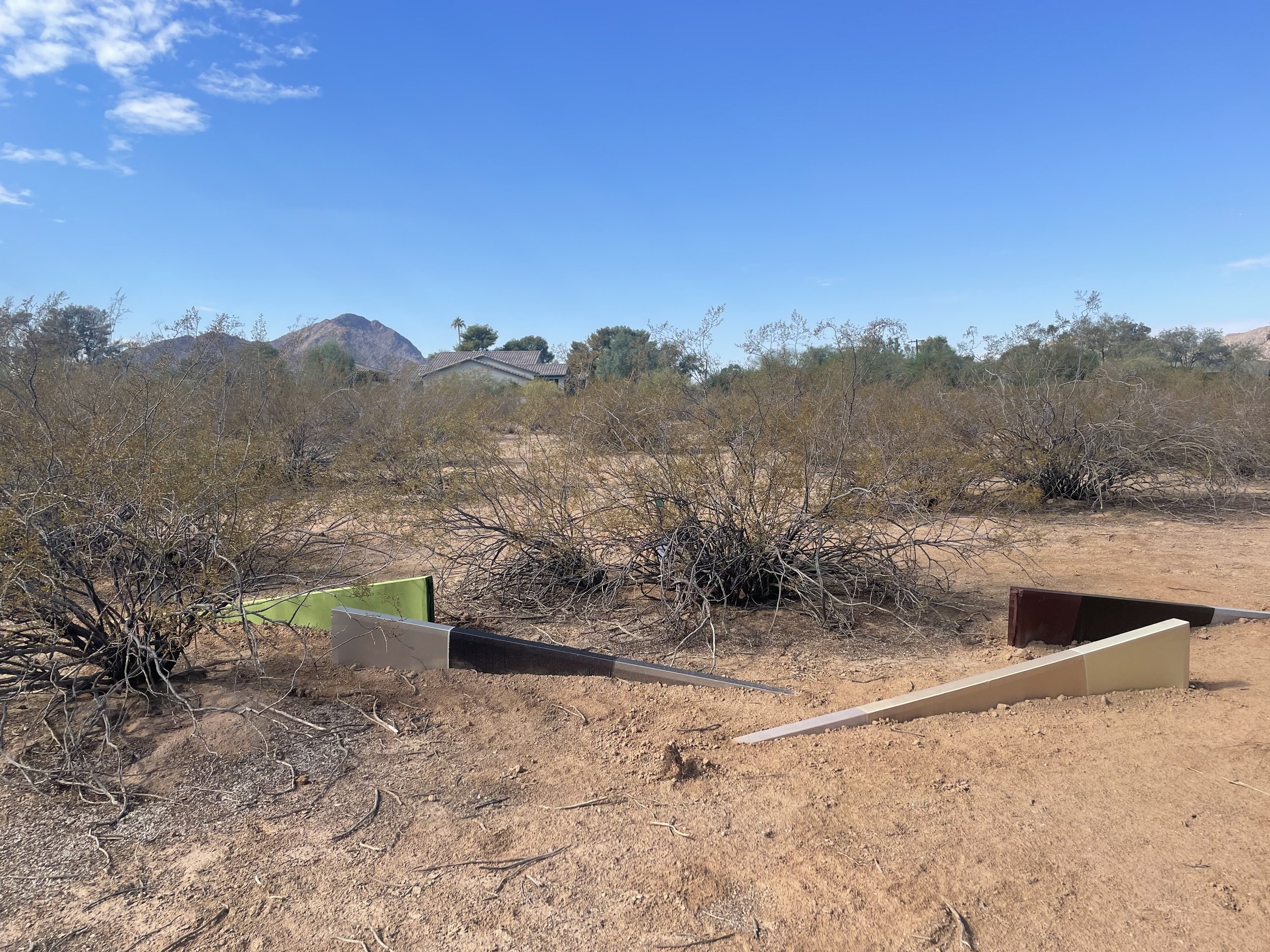Scottsdale Museum of Contemporary Art (SMoCA)
On View September 2025 - February 2026
James Perkins: Post-Totem Poetics and the Ecology of Form
Reimagining Land Art, Minimalism, and Action Painting through Collaboration with Nature
By Lauren R. O’Connell
As the October sun sinks beneath an expansive sky, James Perkins digs narrow rows into the dusty desert soil. Repetition becomes ritual—a preparation for burial. One after another, the shovel strikes the ground, scattering particulates into the refracted light of twilight. Perkins places silk-wrapped structures into shallow resting places, gently pushing earth up to their delicate surfaces—part buried, part revealed. A performance of intention, a ceremonial act to initiate an interval of chance.
This initial gesture marks the beginning of a prolonged collaboration between artist and nature. His role is momentarily complete. The artist waits, entrusting time and place with the potential for transformation. Over the course of months to years, Perkins allows natural forces to “paint” the silk surfaces. Intense sunlight, desert rains, fragrant creosote, gritty soil, and inquisitive coyotes leave their marks, altering the once monochrome textiles with the residue of the environment. This physical process, organic and unpredictable, is equally conceptual, embracing change and impermanence.
After seven months of transformation, Perkins re-engages the structures, harvesting forms that reveal the land’s subtle interventions. He lifts them from the earth, as if sculpting order from the rawness of the land. The soil is returned, the terrain restored. What emerges are silky surfaces transformed by sustained exposure to elemental forces—works that embody movement, nature, and time.
With deliberate care, these altered materials are recontextualized as painting-like sculptures, bridging the boundary between nature and artifice. Perkins removes transfigured silks from temporary supports, unfolds, and stretches them onto new frames. Others reach their outcome without intervention, emerging organically from the ground. The final works are both monumental and intimate, masculine and feminine, painting and sculpture—testaments to transformation and the fleeting beauty of existence.[1]
Perkins’s unique approach reflects a broader philosophical engagement with artistic traditions, while challenging conventional boundaries through his post-totem philosophy and performative process—an act of burying painting (see figure 1). Perkins’s practice draws from the legacies of Land Art, Minimalism, and Action Painting, yet diverges through a distinctive method: wrapping sculptural forms in textiles and embedding them within specific landscapes for extended durations. During this time, nature becomes his collaborator, imprinting the material through exposure to elemental forces and animal encounters. The resulting color fields, textures, and patterns are not applied, but revealed. Once recovered and transformed into painting-like objects for display, these works become records of a joint effort between artist and land, offering an alternative view of making and understanding art that is rooted in vulnerability, reciprocity, and deep connection.
His philosophy draws on histories of symbolism and identity, reinterpreting the totem as a fluid signifier for the interconnectedness of humans, nature, and the material world. Perkins refers to his works as “post-totem structures,” referencing symbolic forms historically associated with identity and belonging. Throughout time, totems have evolved from ancestral signifiers to expressions of positionality—combinations of social identity, heritage, and experiences. Rather than rejecting the totemic form, Perkins reimagines it as a unifying symbol that challenges the divisions between humanity and the natural world, thus establishing his post-totem philosophy. In “an attempt to find a totem to represent all humankind by inventing a new art making process,” his singular practice recasts Earth itself as a shared totem, inviting expansive inquiry into ideas of value and categorization.[i] Grounded in humility and interdependence, Perkins’s post-totem philosophy offers a counterpoint to the anthropocentrism that defines most art historical movements.
To fully appreciate Perkins’s innovations, it helps to situate his work within the legacy of Land Art and its complex relationship with nature and culture. The first Earthwork emerged in the American Southwest in 1969 with Michael Heizer’s Double Negative—two massive trenches, each 1,500 feet long, 30 feet wide, and 50 feet deep, carved into a mesa in Nevada (see figure 2). Conceived during an era of cultural and civil unrest, this monumental gesture rebelled against modernist formalism, commodification, and the sterile confines of gallery spaces. Yet despite its radical intent, early Land Art often revealed a tension between artistic ambition and ecological care.
As Ben Tufnell notes in his essay “The Body in the Landscape: Land Art, Birth and Burial,” many of the movement’s leading figures were “noncommittal and apolitical” about environmental concerns, and it is “simplistic to assume... that Land Art was an art form of environmental consciousness and protest.”[ii]Earthworks like Double Negative reshaped the land using industrial means, disregarding the cultural and ecological significance of place. Where early Earthworks imposed form upon the land, Perkins reverses this dynamic, allowing the land to shape the work through a ritualistic, durational collaboration. He trades monumentality for impermanence, authorship for reciprocity, offering an alternative way of making and experiencing art that is attuned to the rhythmic cycles of the land.
Perkins’s practice is shaped by diverse environments, each demanding distinct responses and fostering unique dialogues between art and ecosystem. While his primary studio is located on Fire Island in New York, his work extends across the Sonoran Desert, a vineyard in Napa Valley, and even a sailboat in the Atlantic Ocean. Each site brings its own elemental conditions and ecological responses. On Fire Island, his structures quietly coexist with fauna—deer and fawns are known to rest beside the works—and encounter the erosive combination of humidity, ocean spray, sea salt, sun, sand, and winds that can reach hurricane speeds. The Sonoran Desert presents the structures with an intense, arid climate and elicits an active engagement with coyotes tearing into the materials in nightly play. These chance meetings reflect Perkins’s openness to adaptability and his commitment to chance as an artistic force. When these environ-altered works are brought into gallery spaces, they bridge the human-made and the natural, becoming material evidence of life beyond singular authorship, shaped by the influence of artist, animals, plants, climate, and terrain.
This interplay echoes conceptual frameworks articulated by Robert Smithson, particularly his notions of site and nonsite.[iii] Bridging outdoor process and indoor presentation, Perkins draws on Smithson’s concept to explore the tension between raw landscape and its abstract representation within the gallery. Like Smithson, Perkins is interested in how meaning shifts when elements of the natural world are displaced and recontextualized. Perkins’s works, though exhibited in controlled, interior settings, retain the essence of the site in which they were formed, becoming vessels of environmental memory. They carry with them the evidence of exposure over time, highlighting the forces that shape their surfaces as much as the artist’s hand.
Perkins’s creative process also shares affinities with Minimalism’ systematic repetition and geometric structure, Action Painting’s physicality, and Color Field Painting’s tonal resonance. Like the Minimalists, Perkins privileges simplicity and seriality, yet departs from the movement’s technical precision by allowing nature to intervene in the outcome. His post-totem structures, as previously described, soften the clean edges and fixed forms associated with Donald Judd or Barnett Newman. His post-totemic forms embody a sense of impermanence and vulnerability, extending the Minimalist ethos into a temporal and ecological dimension. In Perkins’s practice, objects are not static or closed, but open systems, shaped through an ongoing exchange with the environment
Perkins engages with his materials in a way that prioritizes gesture, movement, and spontaneity within his performative process of burying and harvesting the structures, like Action Painters such as Jackson Pollock, but with the additional action of natural forces like wind to shape his canvases. Perkins tempers Action Painting’s raw energy and immediacy with a sensitivity to material and time. In terms of visual impact, his finished works evoke the quiet intensity of Color Field Painting, particularly that of Mark Rothko. Both artists create immersive fields of color that invite introspection, but where Rothko uses layered pigments to produce emotional depth, Perkins relies on organic processes, such corrosion and bleaching, to form subtle gradients and textures on the textile’s dyed surface. The result is a body of work that merges performativity with meditative visual stillness, bridging the physicality of Action Painting with the contemplative aura of Color Field Painting.
Ultimately, Perkins invites us to view his art as a living, evolving exchange between humans and the environment. In his work, the landscape is not simply a backdrop—it is a collaborator, a co-creator, and a witness to transformation. His post-totem structures exist in dialogue with nature, resisting permanence and embracing the porous boundary between intention and chance. By working with the land rather than upon it, Perkins simultaneously continues and redefines art historical legacies, not through monumentality, but through an attunement to place. As Smithson once wrote, “One’s mind and the earth are in a constant state of erosion, mental rivers wear away abstract banks, brain waves undermine cliffs of thought, ideas decompose into stones of unknowing, and conceptual crystallizations break apart into deposits of gritty reason.”[iv] In Perkins’s practice, this erosion is not a loss but a revelation—a way of understanding art as a living process shaped by both material and mind, both nature and human gesture. It reminds us that meaning, like the land, is never fixed, but is weathered, shifting, and endlessly becoming.
Figure 1: James Perkins burying his post-totem structures in the Sonoran Desert, 2024. Photo by the author.
Figure 2: View of Michael Heizer’s Double Negative in 2023. Photo by Jay Atherton.
[1] Written based on the author’s observation of the artist working in collaboration with the Sonoran Desert during a residency at Cattle Track Arts Compound in Scottsdale, Arizona, in October 2024 and April 2025.
[i] James Perkins in an email to the author and Brian Passey, May 30, 2025.
[ii] Ben Tufnell, “The Body in the Landscape: Land Art, Birth and Burial,” in In Land: Writings Around Land Art and Its Legacies (John Hunt Publishing, 2019), p 68.
[iii] Robert Smithson, “A Provisional Theory of Nonsites,” 1968: https://holtsmithsonfoundation.org/provisional-theory-nonsites
[iv] Robert Smithson, “A Sedimentation of the Mind: Earth Projects,” 1968: https://holtsmithsonfoundation.org/sedimentation-mind-earth-projects
Cattle Track Arts Compound is a historic arts community known for its national and local designations. Originating as a homestead in 1937, Cattle Track Arts is now one of Scottsdale’s longest-functioning artist communities, founded by George and Rachael Ellis. The original homestead occupied a strip of undeveloped land next to an unlined pioneer irrigation ditch (Arizona Canal) in the vast, unpopulated desert. The area had earned the moniker “cattletrack” from the cowboys driving their cattle along the canal to auction houses and feedlots. Over the years, George, an engineer, built several adobe and wood houses on the property, many still in use today. Rachael, a schoolteacher and equestrian, became a well-known fashion designer in Scottsdale. In the 1950s, the homestead became a meeting place for creatives to socialize with fellow artists, writers, musicians, and politicians, such as Supreme Court Justice Sandra Day O’Connor. Both local and visiting artists populated the various dwellings throughout the years, including New York sculptor Louise Nevelson and Arizona painter Dorothy Fratt. Jean Lipman, author and longtime editor of Art in America Magazine, frequented Cattle Track after moving to Arizona in the early 1970s. Today, George and Rachael’s daughter Janie Ellis, a former Balanchine ballerina and choreographer, manages the 11-acre compound, which includes a gallery and 35 artist studios.












